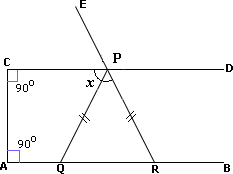Solved Examples and Worksheet for Properties of Isosceles Triangles
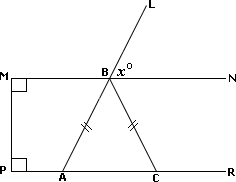
A. 52
B. 58
C. 63
D. 54
Step: 1
[Corresponding angles are congruent.]
Step: 2
[Substitute m ∠
Step: 3
In ΔABC, AB ¯ BC ¯ ⇒ ∠ ∠
[Isosceles triangle theorem.]
Step: 4
[Step 2.]
Step: 5
[Triangle Angle-Sum theorem.]
Step: 6
[Substitute.]
Step: 7
[Simplify.]
Correct Answer is : 54
Step: 1
CD || AB
[m ∠ m ∠
Step: 2
[Same side Interior angles theorem.]
Step: 3
[Substitute m ∠
Step: 4
[Simplify.]
Step: 5
In ΔPQR, PQ ¯ PR ¯ ⇒ ∠ ∠
[Isosceles triangle theorem.]
Step: 6
[Substitute m ∠
Correct Answer is : 72
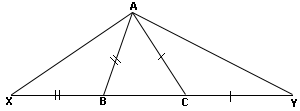
A. 113
B. 117
C. 121
D. 119
Step: 1
In ΔXAB, ∠ ∠ ∠
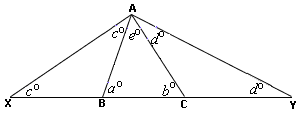
[In a triangle, an exterior angle is equal to the sum of the opposite interior angles.]

Step: 2
In ΔXAB, AB = BX ⇒ ∠ ∠
[Isosceles triangle theorem.]
Step: 3
[Step 1 and Step 2.]
Step: 4
[Rearrange.]
Step: 5
[Substitute.]
Step: 6
[Simplify.]
Step: 7
Similarly, in ΔACY, m ∠ 1 2 m ∠
Step: 8
[Substitute.]
Step: 9
[Simplify.]
Step: 10
In ΔABC, m ∠ m ∠ m ∠
[Triangle-Angle-Sum theorem.]
Step: 11
[Substitute.]
Step: 12
[Simplify.]
Step: 13
[Angle addition postulate.]
Step: 14
Here a b e c d
Step: 15
[Substitute.]
Step: 16
Correct Answer is : 117
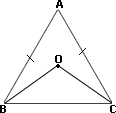
A. 131.50
B. 121.50
C. 129.50
D. 136.50
Step: 1
In ΔABC, m ∠ m ∠ m ∠
[Triangle Angle-Sum theorem.]
Step: 2
In ΔABC, AB = AC ⇒ ∠ ∠
[Isosceles triangle theorem.]
Step: 3
83 + m ∠ m ∠
[Step 1 and step 2.]
Step: 4
2(m ∠
[Simplify.]
Step: 5
[Solve for ∠
Step: 6
[Step 2.]
Step: 7
[OB ¯ ∠
Step: 8
[OC ¯ ∠
Step: 9
In ΔBOC, m ∠ m ∠ m ∠
[Triangle Angle sum theorem.]
Step: 10
[Substitute.]
Step: 11
[Simplify.]
Correct Answer is : 131.50
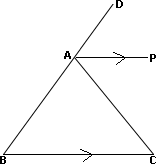
A. 66
B. 57
C. 62
D. 61
Step: 1
[Given.]
Step: 2
Let m ∠ x
Step: 3
[Corresponding angles postulate.]
Step: 4
[AP ¯ ∠
Step: 5
[Substitute m ∠ x
Step: 6
[Alternate interior angles theorem.]
Step: 7
[m ∠ m ∠
Step: 8
[Step 3 and Step 7.]
Step: 9
[m ∠
Correct Answer is : 57
A. 45
B. 60
C. 90
D. 36
Step: 1
Let m ∠ α m ∠
Step: 2
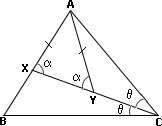
Step: 3
[CX ¯ ∠
Step: 4
In ΔAXY, AX = AY ⇒ m ∠ m ∠
[Isosceles triangle theorem.]
Step: 5
Step: 6
[Rearrange.]
Step: 7
In ΔXBC, m ∠ m ∠ m ∠
[Exterior angle theorem.]
Step: 8
[Substitute.]
Step: 9
[Rearrange.]
Step: 10
[Same angle.]
Step: 11
[Step 6 and step 11.]
Step: 12
[Given that m ∠
Correct Answer is : 36
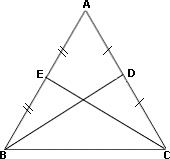
A. 10 cm
B. 8 cm
C. 6 cm
D. 13 cm
Step: 1
As AB ¯ AC ¯ ⇒ ∠ ∠
[Isosceles Triangle.]
Step: 2
ΔEBC = ΔDCB
[SAS property.]
Step: 3
CE = BD = 8 cm
[ΔEBC ≅
Correct Answer is : 8 cm
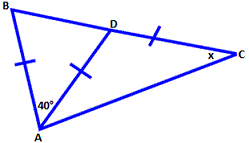
A. 70°
B. 55°
C. 45°
D. 35°
Step: 1
In ΔACD, AD = CD ⇒ m m x
[Isosceles triangle theorem.]
Step: 2
In ΔADB, m m m x x x
[Exterior angle theorem.]
Step: 3
In Δ ADB, AD = AB ⇒ m m x
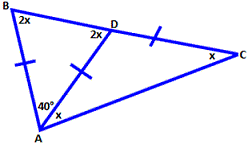
[Isosceles triangle theorem.]

Step: 4
In ΔADB, m m m
[Triangle-Angle-Sum theorem.]
Step: 5
2x x
Step: 6
4x
Step: 7
Therefore, x 1 4 0 ° 4
Correct Answer is : 35°
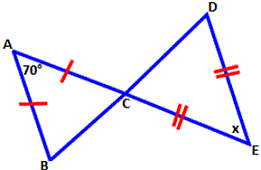
A. 65°
B. 55°
C. 70°
D. 60°
Step: 1
Let m y
Step: 2
In ΔABC, AB = AC ⇒ m m y
[Isosceles triangle theorem.]
Step: 3
[Vertically Opposite angles are equal.]
Step: 4
In ΔCDE, CE = DE ⇒ m m y
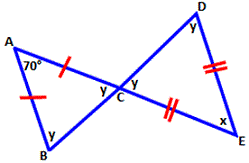
[Isosceles triangle theorem.]

Step: 5
In ΔABC, m m m
[Triangle-Angle-Sum theorem.]
Step: 6
Step: 7
2y
Step: 8
So y 1 1 0 ° 2
Step: 9
in ΔCDE, m m m
[Triangle-Angle-Sum theorem.]
Step: 10
Step: 11
Step: 12
Therefore, x
Correct Answer is : 70°
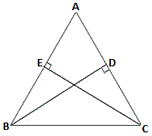
A. ΔABC may be an equilateral triangle
B. ΔABC may be an isoceles triangle
C. ΔABC is a scalene triangle
D. ΔABC is an isoceles or an equilateral triangle
Step: 1
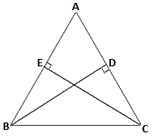
Step: 2
Area of ΔABC = 1 2 1 2
[Area of triangle = 1 2
Step: 3
So, AB = AC
[BD = CE.]
Step: 4
Therefore, ΔABC is an isosceles or an equilateral triangle
[From Step 3]
Correct Answer is : ΔABC is a scalene triangle
- Points, Rays, Angles, Lines and Line Segments-Geometry-Solved Examples
- Parallel Lines and Transversals-Geometry-Solved Examples
- Angle Sum Theorem and Medians in a Triangle-Geometry-Solved Examples
- Proving Quadrilateral is a Parallelogram-Geometry-Solved Examples
- ASA and AAS Postulates -Triangle Congruence-Geometry-Solved Examples
- SSS and SAS Postulates-Triangle Congruence-Geometry-Solved Examples
- Transformations-Reflections-Geometry-Solved Examples
- Transformations-Rotations-Geometry-Solved Examples
- Transformations-Translations-Geometry-Solved Examples
Related Worksheet
- Isosceles Right Triangle
- Isosceles Triangle
